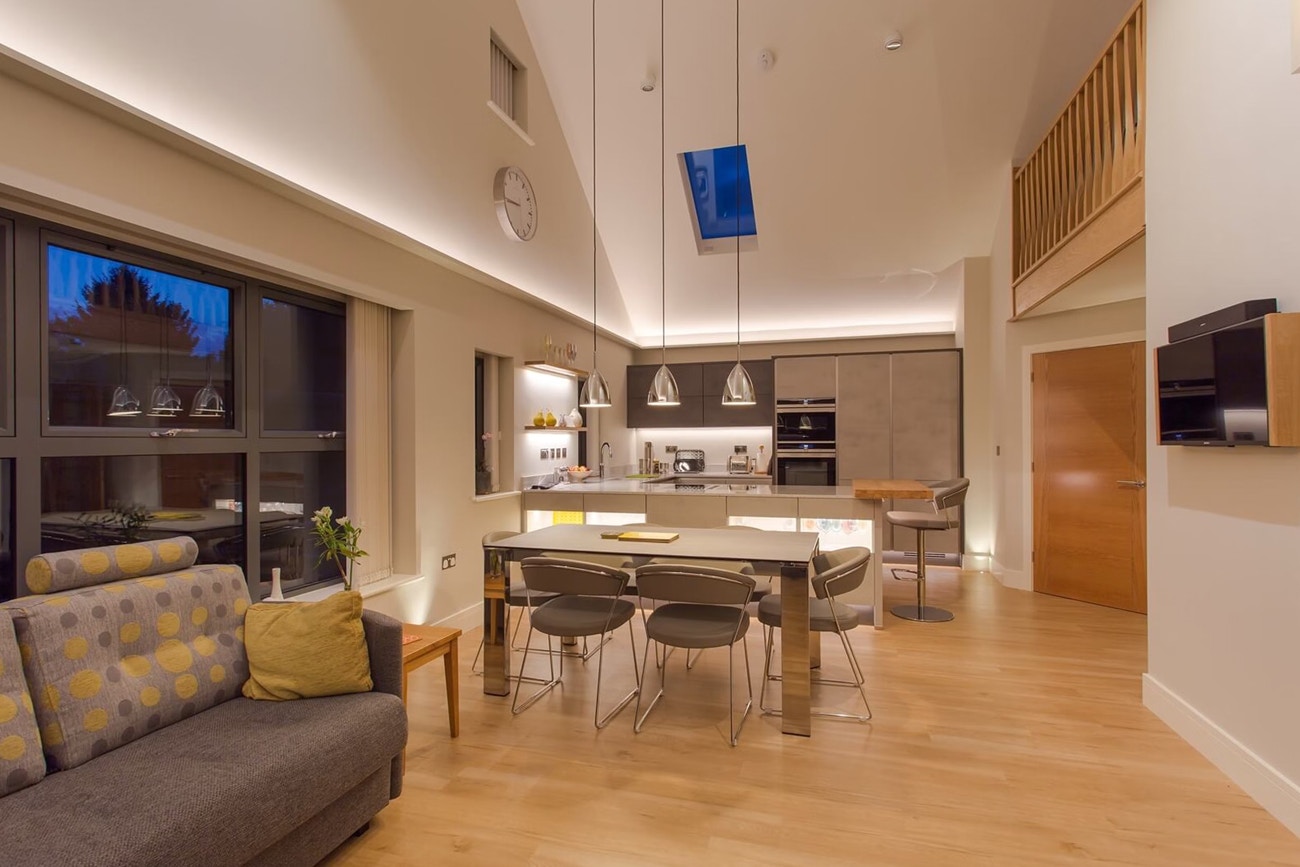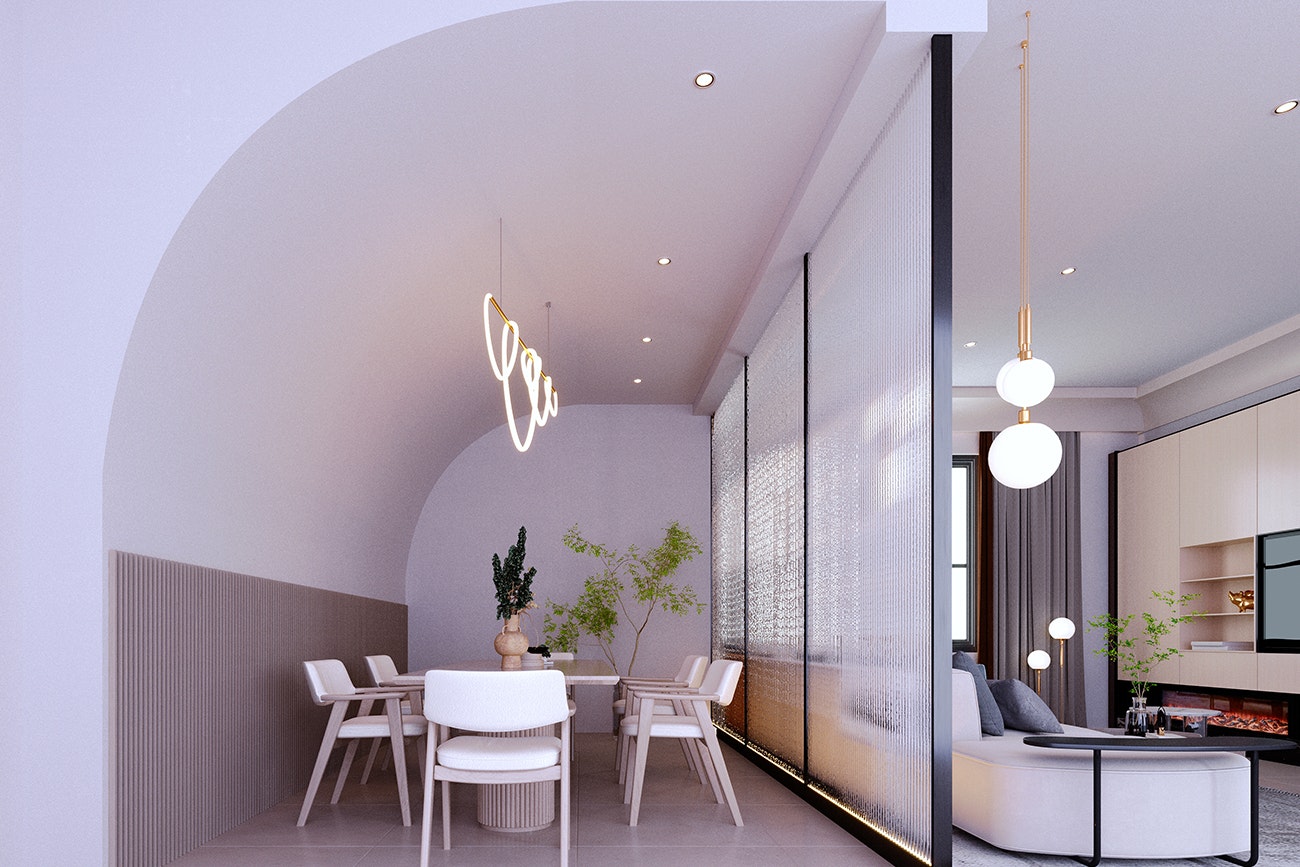Blog
Getting Sloped Ceiling Lighting Right

Author: Bradley Devenish
Sloped or vaulting ceilings are found frequently in both older and modern homes. Whether it’s due to a popular architectural style of the time or through necessity when building the home, sloped ceilings are everywhere. In many cases, the entire house doesn’t have a sloped ceiling, but it may be used as an architectural statement in living areas or even upstairs rooms.
Cathedral ceilings, or vaulted ceilings, are more symmetrical, with both sides of the ceiling meeting at a central point. However, many architectural statement ceilings only slope one way. Regardless of how your home is designed, sloped ceilings can present an additional challenge when designing effective sloped roof lighting.
Effective lighting is all about creating an atmosphere in your home, making it more comfortable to live in. Plus, aesthetic design appeal is always important. Here’s what you need to know about lighting for sloped or vaulted ceilings.
Can you use downlights on sloped ceilings?
One of the most common lighting types in UK homes is downlighting. Downlights are also known as recessed lights because they sit flush against the ceiling. Traditionally, downlights are used on flat ceilings, sending light directly to the floor. From there, it can effectively bounce around the room, which is why downlights are so effective.
The issue with using downlights on sloped ceilings is that the direction of the light is wrong. With sloped ceilings that meet in a single apex, downlights would be shining light directly into the middle of the room rather than onto the floor. In rooms with just one slope, you could end up with downlights all pointing in the same direction, providing very little light to one-half of the room.
With that being said, when planning slanted ceiling lights, you can use recessed lighting, provided you choose directional downlights. This clever technique allows your downlights to point where they’re supposed to – straight down.
Pendant lights
Another popular type of sloped ceiling lighting is pendant lights. These are extremely effective when planning lighting for a slanted ceiling. Pendants are always stylish for any room and can look incredible when paired with track lighting. When choosing pendant lighting, keep a few things in mind.
You will need to consider the structure of your sloped ceiling. If you have plenty of exposed beams, as many sloped ceilings do, you can cleverly use pendants hanging from beams. This also helps you create a sense of symmetry.
You’ll also need to ensure you get the right type of pendant lights. Most should be okay, but some pendant lights won’t hang correctly on an angle. Make sure you ask your lighting designer for options with the right type of ceiling rose to handle a sloped ceiling.
Pendant height
The height of the pendant lighting is also important. Ultimately, this comes down to personal choice, but vaulted or sloped ceilings give you extra room to move here. Due to the added height, you can create larger drops or smaller drops depending on your needs.
Generally, there should be 7 feet between the light and the floor. You’ll need to keep this in mind, especially when the hanging height may vary depending on your placement. Adjust the drop height accordingly to ensure pendant lights all have the same distance to the floor.
Finally, if you want to hang your pendant lights from the ceiling’s apex, you may need to get creative. If there is a beam to use, you’re all set. However, if there is no middle beam, you may need to consider a canopy box to create a horizontal surface to hang lights from.
The hang and drop technique
If you’re ready to try something really creative with your pendant lighting, consider the hang and drop technique. This can be useful in a number of sloped ceiling situations.
Essentially, it involves using the sloped parts of your ceiling to install the ceiling rose as you would normally. However, you also use hooks closer to the apex (the middle of the room). The cable from your pendant light then runs through the hook, and your pendant light is now hanging in a more central position.
This technique can also be used in single-slope rooms by attaching hooks in the centre of the slope, and your ceiling rose flush on the wall. Your sloped ceiling pendant lights hang from the hooks while secured to the side wall. When done properly, this creates a beautiful design aesthetic for any modern home.
Spot lights
One of the most common parts of the home we see sloped ceilings is in the kitchen. As a result, you need to consider task lighting because this is where you prepare meals. If your other choices of lights for the slanting ceiling don’t provide enough light over your benchtops, you’ll need to find other alternatives.
Spot lights can be highly effective in the kitchen, but there are some things to consider. The presence of spot lights can create shadows on the wall, so ideally, you should keep fixtures around 3ft from the wall to minimise this. You also don’t want your ceiling fully covered in different light fixtures because it just looks tacky and too busy. So, try to stick with wall-mounted spot lights.
Of course, every space is different, so it’s best to consult a professional lighting designer to help with sloped ceiling lighting ideas for your home. Just as no two houses are the same, no lighting design is entirely the same.
Track lighting
Track lighting is another popular method for lighting rooms with vaulted ceilings. It’s particularly effective if the room has a lot of exposed beams, as these can serve as anchor points for your track. The great thing about using track lighting with vaulted ceilings is that it accentuates the architecture. The entire upper section of the ceiling can be lit beautifully with a series of cleverly positioned track lights.
Track lighting is also an efficient way to light certain parts of the room, such as a dining table. You can provide more than enough light for meals by placing several lights on a single strip. As long as the track lights aren’t too bright, you can create a wonderful ambience with this method.
Remember that track lighting is more of a secondary light source. Your recessed light fixtures should still be your primary light source, but track lights can complement the rest of your slanted ceiling lights.
Other sloped ceiling lighting tips

Like any design choice, lighting for sloped ceilings should incorporate easily into the home’s interior design. Every home is different, so there’s no one-size-fits-all recommendation for how to manage your sloped ceilings. Much like successfully lighting rooms with low ceilings, there are always challenges with a sloped ceiling. However, with expert advice, you can create a sense of luxury in your home. Here are some extra tips for lighting rooms with vaulted ceilings.
Make use of dimmers
Like any room in the house, dimmers are essential for creating the right ambience. Whether you use a smart lighting system or not, having dimmers available gives every room in the house a wider range of uses.
For example, if you have a living room with a sloped ceiling, you may want the room flooded with light while entertaining friends or while the kids play during the day. At night, if you want to relax with a book or a movie, dimming the lights creates a much more relaxing environment.
Dimming the lights can also help you wind down at the end of the day because lower intensity light is better for your circadian rhythm as you get closer to bedtime.
Use layered lighting
Remember, a room with great lighting design doesn’t just feature one set of lights. Remember the three pillars of lighting – ambient, task and accent. Your ambient light creates the right environment for each room, while task lighting is used for specific tasks like cooking. Accent lighting can be used to cleverly highlight architectural features of the home or even special decorations. You don’t need all the lights on at once, but you should always have options for different types of lighting.
Get the right amount of light
Layered lighting is terrific for any home, but you must understand how much light you need. This should be thought about when planning your lighting. So, consider what you’ll use each room for and plan your lighting accordingly. You may require a range of different lights in a dining room or kitchen, but in a bedroom, you may not need as much variety. With careful planning, you can ensure every room of your home has the perfect amount of light.
Need professional lighting design for your home?
Hampshire Light is a multi-award-winning family-owned business providing professional lighting design services for over 25 years. Our experience is unmatched, and we bring a sense of luxury and innovation to every design project. From stunning homes to commercial properties, our experts are here to help you from planning through to installation and beyond.
If you have sloped ceilings or any other architectural complexities, we can ensure your lighting matches the beauty of your home. Speak with our lighting professionals today and find out how we can enhance your home and your lifestyle.
Are we the right choice for your new build or extensive refurb project?
We believe we are because we have been lighting prime properties for the past 25 years and have earned many accolades.
Houzz Rating: 4.9 stars
Best of Houzz Design Awards: 2016, 2017, 2018, 2019, 2020, 2021, 2022
More importantly, people choose us for three reasons:
- End-to-End Service
- Peace of Mind
- Design Within Your Budget
End-to-End Service
We provide end-to-end service. It means we take complete responsibility right from the design to the fitting of your lighting. We also offer interior design services and blinds. This saves you time and makes your task simple. You just have to deal with one company (not 3-4 companies) for your all lighting needs.
Peace of Mind
You get a 100% Design Guarantee - a full refund on your design fee if you’re not satisfied with the design once the design process is complete. (In our industry, no one has this strong a guarantee.)
Design Within Your Budget
Part of your design process ensures that the total project ends up within an affordable budget without sacrificing quality. We have a history with a wide range of suppliers worldwide, which means we can provide options on the lower level, mid-line and premium fittings for you to make educated financial decisions for your project.
Kindly download our brochure. Read what some of our clients are saying about our work.
Want to learn more about lighting design?
Download our lighting design brochure